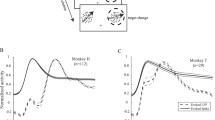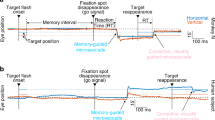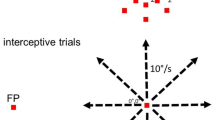Abstract
During visual fixation, we unconsciously make tiny, involuntary eye movements or ‘microsaccades’, which have been shown to have a crucial influence on analysis and perception of our visual environment. Given the small size and high irregularity of microsaccades, it is a significant challenge to detect and extract the microsaccade-related neural activities. In this work, we present a novel application of the independent component analysis with reference algorithm to extract microsaccade-related neural activity from single-trial local field potential (LFP). We showed via extensive computer simulations that our approach can be used to reliably extract microsaccade-related activity. We then applied our method to real cortical LFP data collected from multiple visual areas of monkeys performing a generalized flash suppression task and demonstrated that our approach has excellent performance in extracting microsaccade-related signal from single-trial LFP data.







Similar content being viewed by others
References
Kowler E, Steinman RM (1980) Small saccades serve no useful purpose: reply to a letter by R.W. Ditchburn. Vision Res 20(3):273–276
Martinez-Conde S, Macknik SL, Troncoso XG et al (2006) Microsaccades counteract visual fading during fixation. Neuron 49(2):297–305
Rucci M, Lovin R, Ploetti M et al (2007) Miniature eye movements enhance fine spatial detail. Nature 447(7146):851–854
Martinez-Conde S, Macknik SL, Hubel DH (2004) The role of fixational eye movements in visual perception. Nat Rev Neurosci 5(3):229–240
Herrington TM, Masse NY, Hachmeh KJ et al (2009) The effect of microsaccades on the correlation between neural activity and behavior in middle temporal, ventral intraparietal, and lateral intraparietal areas. J Neurosci 29(18):5793–5805
Hafed ZM, Goffart L, Krauzlis RJ (2009) A neural mechanism for microsaccade generation in the primate superior colliculus. Science 323(5916):940–943
Dimigen O, Valsecchi M, Sommer W et al (2009) Human microsaccade-related visual brain response. J Neurosci 29(39):12321–12331
Leopold DA, Logothetis NK (1998) Microsaccade differentially modulate neural activity in the striate and extrastriate visual cortex. Exp Brain Res 123(3):341–345
Bosman CA, Womelsdorf T, Desimone R et al (2009) A microsaccadic rhythm modulates gamma-band synchronization and behavior. J Neurosci 29(30):9471–9480
Yuval-Greenberg S, Tomer O, Keren AS et al (2008) Transient induced gamma-band response in EEG as a manifestation of miniature saccades. Neuron 58(3):429–441
Lu W, Rajapakse JC (2006) ICA with reference. Neurocomputing 69:2244–2257. doi:10.1016/j.neucom.2005.06.021
Lin Q, Zheng Y, Yin F et al (2007) A fast algorithm for one-unit ICA-R. Inf Sci 177(5):1265–1275
Huang D, Mi J (2007) A new constrained independent component analysis method. IEEE Trans Neural Netw 18(5):1532–1535
Llinares R, Igual J (2009) Application of constrained independent component analysis algorithms in electrocardiogram arrhythmias. Artif Intell Med 47(2):121–133
Rasheed T, Lee Y, Lee SY et al (2009) Attenuation of artifacts in EEG signals measured inside an MRI scanner using constrained independent component analysis. Physiol Meas 30(4):387–404
Wilke M, Logothetis NK, Leopold DA (2003) Generalized flash suppression of salient visual target. Neuron 39(6):1043–1052
Wilke M, Logothetis NK, Leopold DA (2006) Local field potential reflects perceptual suppression in monkey visual cortex. Proc Natl Acad Sci USA 103(46):17507–17512
Cui J, Wilke M, Logothetis NK et al (2009) Visibility states modulate microsaccade rate and direction. Vision Res 49(2):228–236
Hyvarinen A (1998) New approximations of differential entropy for independent component analysis and projection pursuit. In: Jordan MI, Kearns MJ, Solla SA (eds) Advances in neural information processing systems, vol 10. MIT Press, Cambridge, pp 273–279
Xu L, Stoica P, Li J et al (2009) ASEO: A method for the simultaneous estimation of single-trial event-related potentials and ongoing brain activities. IEEE Trans Biomed Eng 56(1):111–121
Wang Z, Maier A, Leopold DA et al (2007) Single-trial evoked potential estimation using wavelet. Comput Biol Med 37(4):463–473
Acknowledgments
This work is partially supported by NIH. We thank Dr Melanie Wilke for proving the data, which were collected at the laboratory of Dr Nikos Logothetis at Max Planck Institute for Biological Cybernetics in Germany.
Author information
Authors and Affiliations
Corresponding author
Rights and permissions
About this article
Cite this article
Hu, M., Zhang, H. & Liang, H. Extraction of microsaccade-related signal from single-trial local field potential by ICA with reference. Neural Comput & Applic 20, 1181–1186 (2011). https://doi.org/10.1007/s00521-010-0469-2
Received:
Accepted:
Published:
Issue Date:
DOI: https://doi.org/10.1007/s00521-010-0469-2




